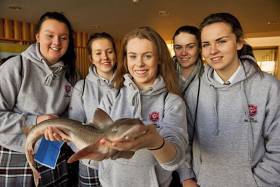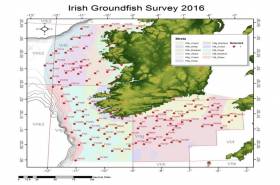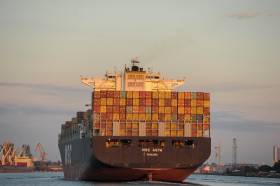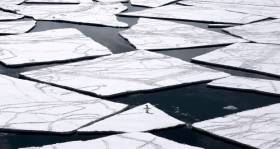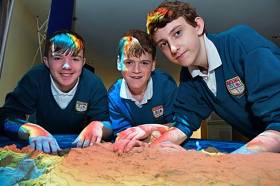Displaying items by tag: marine science
#MarineScience - The public consultation on a new plan setting out Ireland's Marine Research and Innovation Strategy for the period 2016-2021 has been extended till Friday 30 December.
As previously reported on Afloat.ie, the draft strategy as prepared by the Marine Institute provides a unified view of marine-related funding requirements across a range of societal challenges such as transport, food, energy and biodiversity.
And it aims to build on the significant progress made during the implementation of Ireland's previous marine research, knowledge and innovation strategy, Sea Change 2007-2013.
Details on the consultation’s online survey can be found HERE.
Open Day For All At Marine Institute This Week
#MarineScience - The Marine Institute welcomed over 250 visitors to its headquarters in Oranmore for the maritime innovation agency’s annual open day on Wednesday (23 November).
Organised as part of the Galway Science & Technology Festival and designed mainly for Transition Year students, this year the Marine Institute decided to open its doors to all, and attracted Leaving Cert students, teachers and parents, plus university and community groups from across the country.
Visitors had the opportunity to tour the state-of-the-art facilities in Oranmore and to meet with researchers and scientists and hear about their careers in the marine sector, which already supports over 30,000 direct and indirect jobs.
The institute also organised a series of interactive exhibitions to introduce visitors to some of the innovative work happening in areas including seabed mapping, research vessel operations and oceanography, as well as fisheries and the marine environment.
Find out more about the Marine Institute and its work at the Galway and Science & Technology Festival Exhibition this Sunday 27 November at NUI Galway from 10am till 6pm.
Marine Notice: Annual Groundfish Survey Off South & West Coasts
#MarineNotice - The Marine Institute advises that the annual Irish Groundfish Survey (IGFS2016) will be carried out off the South and West coasts of Ireland between Monday 14 November and Sunday 18 December in fulfilment of Ireland’s Common Fisheries Policy obligations.
The IGFS is a demersal trawl survey consisting of a minimum of 125 fishing hauls of 30 minutes duration each. Fishing in 2016 will take place within a 2nm radius of the positions indicated in Marine Notice 44 of 2016, available to read or download HERE.
The survey will be conducted by the RV Celtic Explorer (Callsign EIGB), which will display all appropriate lights and signals during the survey and will also be listening on VHF Channel 16. The vessel will be towing a high headline GOV 36/47 demersal trawl during fishing operations.
The Marine Institute requests that commercial fishing and other marine operators keep a 2nm area around the tow points clear of any gear or apparatus during the survey period.
While there is no statutory provision for the loss of gear at sea, the Marine Institute will make every effort to avoid gear adequately marked according to legislation that may be encountered in the notified areas.
In the event that an operator has static gear or other obstructions within 2nm of the points listed above it is the responsibility of the owner to notify the survey managers or vessel directly. This should be communicated by identifying specifically which ‘Prime Station’ is of concern using the appendix and contact details provided in the Marine Notice. It is not required to provide positional details of commercial operations beyond 3-4nm of the survey points provided.
Specifics of any fishing gear or other obstructions that are known and cannot be kept clear of these survey haul locations can be notified using the contact details provided in the Marine Notice.
Views Sought On New Marine Research & Innovation Strategy 2021
#MarineScience - A new plan setting out Ireland's Marine Research and Innovation Strategy for the period 2016-2021 is now available for public consultation until Tuesday 22 November.
The draft strategy, prepared by the Marine Institute, provides a unified view of marine-related funding requirements across a range of societal challenges such as transport, food, energy and biodiversity.
It aims to build on the significant progress made during the implementation of Ireland's previous marine research, knowledge and innovation strategy, Sea Change 2007-2013.
The strategy has been developed following detailed review of marine research performance in Ireland, as well a review of the major policy and sectoral drivers.
A key aim of the strategy is to provide a guide for Government and funding agencies to where there are gaps in marine research to meet the needs of society as stated in national strategies such as Innovation 2020, the national research and innovation strategy.
"Significant progress has been made in marine research and it has become clear that marine research in Ireland has moved from being what was considered by some as a niche field, to a theme that is integral to the development of many sectors such as energy, transport, food, and biodiversity,” said Marine Institute chief executive Dr Peter Heffernan.
The strategy aims to raise the research capacity across a number of identified themes and to ensure that funding is targeted to match requirements highlighted in state policies and sectoral plans.
"There is a high degree of co-ordination in the State's approach to research funding, as we have seen through the national research prioritisation exercise and more recently the publication of Innovation 2020,” added Dr Heffernan.
“We hope the Marine Research and Innovation Strategy will contribute to that coordinated approach by providing important insights to funding agencies as to how best to target their resources in the cross cutting area of marine research."
All citizens and organisations are welcome to contribute to this consultation.
“We've chosen to make the document available to as wide an audience as possible through public consultation in the spirit of engaging with the sea, a key goal of Harnessing Our Ocean Wealth, Ireland's integrated marine plan,” said Dr Heffernan. “We hope that as many people as possible will contribute to the consultation process.”
The purpose of the public consultation is to collect views and opinions on the strategy, its scope, objectives, and expected impacts.
View the draft Marine Research and Innovation Strategy and give your feedback no later than 5pm on Tuesday 22 November. Feedback from the consultation will be analysed and considered by the Marine Institute before the strategy is finalised.
Ten questions have been designed to capture your views on the strategy. Complete the online survey HERE or email your responses to [email protected].
Consultation questions and background briefing documents are also available.
IMO Reach Agreement to Keep 2020 for 0.5% Global Sulphur Cap
#GlobalSulphur - The International Maritime Organistions IMO’s Marine Environment Protection Committee (MEPC) has reached an agreement on global sulphur cap.
The IMO last week agreed in favour of maintaining the deadline of 2020 for introducing a global cap of 0.5% sulphur content in marine fuels.
Responding to the breakthrough, the European Sea Ports Organisation (ESPO) congratulated the IMO on its decision. By setting 2020 as deadline for this global 0.5% sulphur cap, the IMO timing is being aligned with the EU timing as foreseen in the current Sulphur Directive. This will mean equal rules for EU and its neighbouring countries.
European ports are also convinced of the environmental and public health benefits of this reduction target.
Commenting on th decision, ESPO’s Secretary General Isabelle Ryckbost said “It is clear that limiting the sulphur exhaust emissions can have an enormous impact on the local air quality. This decision thus means a big step forward for the maritime and port industry and the people around the ports. In fact, 90% of European ports are very close to urban areas. Moreover, by maintaining 2020, IMO shows that an ambitious greening agenda is possible at global level. We must hope that IMO will demonstrate the same level of ambition when addressing climate change”
Former Antarctic Patrol Vessel HMS Endurance Named in Honour of Shackleton’s Ship Scrapped
#ShackletonShips - The Ross Sea announced as the World’s largest marine park in the Antarctic is where ice patrol survey ship HMS Endurance nearly sank in the south Atlantic in 2008. Since then the ship has remained laid up, however in recent months she was scrapped, writes Jehan Ashmore.
HMS Endurance (A171) a former Royal Navy vessel based in the polar seas was named in honour of Sir Ernest Shackleton’s original expedition sail and steam ship Endurance.
The three-masted barquentine, Endurance was crushed by pack ice and sunk more than a century ago in late 1915. The incident took place during the Imperial Trans-Antarctic expedition of 1914-1918 led by the Irish born polar explorer. A 15ft model of the ship is on display in the Athy Heritage Museum, Co. Kildare and more recently a statue of Shackleton was unveiled.
The 1995 built HMS Endurance had a near floundering incident in December 2008 while off Chile. The 5,129 gross tonnage vessel suffered flooding of her engine room that nearly sank her, following an error during routine maintenance on a sea suction strainer.
The damage was so severe that HMS Endurance was transported by semi-submersible ship to the UK, firstly Dartmouth and then Portsmouth Naval Base. It was deemed far too expensive to carry out repairs and she was sold for scrap in 2013, however since Afloat’s coverage almost three years ago, the towage of the vessel only took place in June when bound for breakers in Turkey.
She had been employed as a hydrographic and support vessel for British Antarctic Survey (BAS), which is responsible for the UK's national scientific activities in Antarctica. A £150m newbuild RRS Sir David Attenborough currently under construction will join her fleetmates as outlined below.
HMS Endurance was originally built as MV Polar Circle for Norwegians in 1990, then chartered to the Royal Navy and purchased. The navy equipped the vessel with Lynx helicopters as BAS aircraft cannot reach certain locations in the vast polar expanse.
Currently, the Royal Navy’s presence in these polar waters and the South Atlantic is tasked to HMS Protector (A173). Likewise of her predecessor, she operates along with BAS ships.
They are the civilian-manned polar research vessels, RRS Ernest Shackleton and RRS James Clarke Ross. The naming of the ship honours that of the British explorer who in 1841 visited the area (Ross Sea) located in southern Antarctica.
Ross Sea Creates World’s Largest Marine Park in Antarctica
#AntarcticPark - The European Union and 24 countries yesterday agreed to create the world’s largest marine park in the Antarctic Ocean, covering a massive 1.55 million square km (600,000 square miles) of ocean.
The Irish Times writes the Commission for the Conservation of Antarctic Marine Living Resources, meeting in Hobart, Australia, said the Ross Sea marine park would be protected from commercial fishing for 35 years.The Ross Sea is seen as one of the world’s most ecologically important oceans.
The sanctuary will cover more than 12 per cent of the Southern Ocean, which is home to more than 10,000 species including most of the world’s penguins, whales, seabirds, colossal squid and Antarctic tooth fish.
Fishing will be banned completely in 1.1 million square km (425,000 square miles) of the Ross Sea, while areas designated as research zones will allow for some fishing for krill and sawfish.
Scientists and activists described the agreement as a historic milestone in global efforts to protect marine diversity.
For more the newspaper has the report here.
Mystery Of Fin Whale Beaching On UK’s North Sea Coast
#MarineWildlife - Marine scientists have been puzzled by the recent beaching of a whale rarely seen off the east coast of England.
According to the Guardian, the carcass of a 12m fin whale washed up at Holkham in Norfolk last Thursday afternoon (20 October), far from its usual waters between Britain and Ireland.
“You never get them in the North Sea, so what it was doing there, we have no idea at the moment,” biologist Dr Ben Garrod told the newspaper.
It’s not yet known what causes the marine giant’s death, though collision with a vessel in the North Sea has been mooted as one possibility, as the Eastern Daily Press reports.
#MarineScience - As previously highlighted on Afloat.ie, the Marine Biotechnology Research and Innovation Roadmap was launched by the EU-funded Marine Biotechnology Consortium (ERA-MBT) last week in Brussels.
The consortium brings together 19 partners from 14 countries across Europe to work with stakeholders in identifying marine biotechnological needs, and gaps in the value chain in an attempt to increase the valorisation of marine bioresources.
Developing a roadmap for future research and innovation was a key project deliverable, and it will now set the direction for future marine biotechnology developments and transnational activities in Europe.
Ireland's Marine Institute is a partner in ERA-MBT and led the development of the Marine Biotechnology Strategic Research and Innovation Roadmap. Chief executive Dr Peter Heffernan congratulated all those involved in the development of the roadmap, in particular Dr Dermot Hurst, who led the Marine Institute's contribution.
"The role played by the Marine Institute in supporting the development of Ireland's marine biotechnology research capabilities through funds awarded to the NutraMara and Beaufort Biodiscovery projects has placed Ireland in a strong international position as a recognised leader in marine biotechnology and related research,” said Dr Heffernan.
Today's bioeconomy is advancing faster and showing greater promise than ever before, driven by both scientific advances and markets demanding sustainable solutions to todays global grand challenges of food and fuel security, sustainable industry and population health.
The global market for marine biotechnology has the potential to reach €5.8 billion by 2025, and Europe is recognised as a high-potential region for future growth resulting from an extensive, yet largely unexplored marine resource.
The Marine Biotechnology Strategic Research and Innovation Roadmap, which is available to download HERE, has been developed to support the development of marine biotechnology research and innovation, enabling its growth within a self-sustained enterprise driven network. The roadmap provides a practical and realistic approach by which marine bioresources and biotechnology can contribute to economic and societal progress.
National and European policy organisations can use the roadmap in developing measures to maximise the contribution of the oceans’ bioresources to the bioeconomy and societal welfare, and funding agencies can use it to identify marine biotechnology related research themes.
Speaking from Ireland's perspective, Dr Heffernan added: "This roadmap directs attention to areas of research which are relevant to Ireland's enterprise sector and as such confirms the opportunities described by the Harnessing Our Ocean Wealth Development Task Force regarding marine resource-based industries adding value to their products and services through marine biotechnology."
Marine Institute Open Day In November
#MarineScience - The Marine Institute is set to open its doors for its annual Open Day on Wednesday 23 November from 9.30am to 3pm.
The Open Day at Ireland's national agency for marine research, technology, development and innovation is especially aimed at second level students from Transition Year to the Leaving Cert cycle, their teachers and parents.
Visitors will have the opportunity to tour the state-of-the-art facilities on offer in Oranmore and to meet with researchers and scientists and hear about their careers in the marine.
They will also get to see some of the institute’s innovative work through a series of interactive exhibitions, including seabed mapping, research vessel operations and oceanography, as well as in fisheries and the marine environment.
There are three two-hour sessions available for student groups on the day: 9.30am to 11.30am, 11.15am to 1.15pm and 1pm to 3pm.
Places are limited, and will be allocated on a first come, first served basis. To book, contact Kathleen Sweeney at [email protected] before Friday 28 October.
Last year the Marine Institute hosted some 300 Transition Year students during Science Week as part of the Galway Science & Technology Festival, as previously reported on Afloat.ie.



























